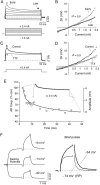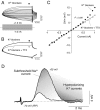Voltage-dependent enhancement of electrical coupling by a subthreshold sodium current
- PMID: 15102915
- PMCID: PMC6729423
- DOI: 10.1523/JNEUROSCI.0077-04.2004
Voltage-dependent enhancement of electrical coupling by a subthreshold sodium current
Abstract
Voltage-dependent changes in electrical coupling are often attributed to a direct effect on the properties of gap junction channels. Identifiable auditory afferents terminate as mixed (electrical and chemical) synapses on the distal portion of the lateral dendrite of the goldfish Mauthner cells, a pair of large reticulospinal neurons involved in the organization of sensory-evoked escape responses. At these afferents, the amplitude of the coupling potential produced by the retrograde spread of signals from the postsynaptic Mauthner cell is dramatically enhanced by depolarization of the presynaptic terminal. We demonstrate here that this voltage-dependent enhancement of electrical coupling does not represent a property of the junctions themselves but the activation of a subthreshold sodium current present at presynaptic terminals that acts to amplify the synaptic response. We also provide evidence that this amplification operates under physiological conditions, enhancing synaptic communication from the Mauthner cells to the auditory afferents where electrical and geometrical properties of the coupled cells are unfavorable for retrograde transmission. Retrograde electrical communication at these afferents may play an important functional role by promoting cooperativity between afferents and enhancing transmitter release. Thus, the efficacy of an electrical synapse can be dynamically modulated in a voltage-dependent manner by properties of the nonjunctional membrane. Finally, asymmetric amplification of electrical coupling by intrinsic membrane properties, as at the synapses between auditory afferents and the Mauthner cell, may ensure efficient communication between neuronal processes of dissimilar size and shape, promoting neuronal synchronization.
Figures









Similar articles
-
Subthreshold sodium current underlies essential functional specializations at primary auditory afferents.J Neurophysiol. 2008 Apr;99(4):1683-99. doi: 10.1152/jn.01173.2007. Epub 2008 Jan 30. J Neurophysiol. 2008. PMID: 18234982
-
Retrograde synaptic communication via gap junctions coupling auditory afferents to the Mauthner cell.J Neurosci. 1995 Sep;15(9):5943-55. doi: 10.1523/JNEUROSCI.15-09-05943.1995. J Neurosci. 1995. PMID: 7666179 Free PMC article.
-
Connexin35 mediates electrical transmission at mixed synapses on Mauthner cells.J Neurosci. 2003 Aug 20;23(20):7489-503. doi: 10.1523/JNEUROSCI.23-20-07489.2003. J Neurosci. 2003. PMID: 12930787 Free PMC article.
-
Physiology of primary saccular afferents of goldfish: implications for Mauthner cell response.Brain Behav Evol. 1995;46(3):141-50. doi: 10.1159/000113267. Brain Behav Evol. 1995. PMID: 8520933 Review.
-
Enhanced transmission of glutamate current flowing from the dendrite to the soma in rat neocortical layer 5 neurons.Novartis Found Symp. 2002;241:61-8; discussion 68-71, 226-32. Novartis Found Symp. 2002. PMID: 11771651 Review.
Cited by
-
Properties of precise firing synchrony between synaptically coupled cortical interneurons depend on their mode of coupling.J Neurophysiol. 2015 Jul;114(1):624-37. doi: 10.1152/jn.00304.2015. Epub 2015 May 13. J Neurophysiol. 2015. PMID: 25972585 Free PMC article.
-
GABABR Modulation of Electrical Synapses and Plasticity in the Thalamic Reticular Nucleus.Int J Mol Sci. 2021 Nov 9;22(22):12138. doi: 10.3390/ijms222212138. Int J Mol Sci. 2021. PMID: 34830020 Free PMC article.
-
Synergy between electrical coupling and membrane properties promotes strong synchronization of neurons of the mesencephalic trigeminal nucleus.J Neurosci. 2012 Mar 28;32(13):4341-59. doi: 10.1523/JNEUROSCI.6216-11.2012. J Neurosci. 2012. PMID: 22457486 Free PMC article.
-
Glycine and GABAA receptors mediate tonic and phasic inhibitory processes that contribute to prepulse inhibition in the goldfish startle network.Front Neural Circuits. 2015 Mar 24;9:12. doi: 10.3389/fncir.2015.00012. eCollection 2015. Front Neural Circuits. 2015. PMID: 25852486 Free PMC article.
-
Electrical synapses and their functional interactions with chemical synapses.Nat Rev Neurosci. 2014 Apr;15(4):250-63. doi: 10.1038/nrn3708. Epub 2014 Mar 12. Nat Rev Neurosci. 2014. PMID: 24619342 Free PMC article. Review.
References
-
- Bartelmez GW (1915) Mauthner's cell and the nucleus motorius tegmenti. J Comp Neurol 25: 87-128.
-
- Bennett MVL (1966) Physiology of electrotonic junctions. Ann NY Acad Sci 137: 509-539. - PubMed
-
- Bennett MVL (1977) Electrical transmission: a functional analysis and comparison with chemical transmission. In: Cellular biology of neurons, Vol I, Handbook of physiology. The nervous system (Kandel ER, ed) pp 357-416. Baltimore: Williams & Wilkins.
Publication types
MeSH terms
Substances
Grants and funding
LinkOut - more resources
Full Text Sources
Miscellaneous
